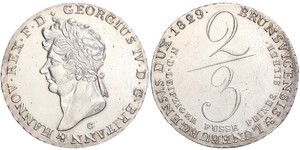2/3 Thaler Kingdom of Hanover (1814 - 1866) Silver George IV (176 ...
1823, Kingdom of Hannover, George IV. Silver 2/3 Thaler Coin. PCGS AU-55!
Mint Year: 1823 References: KM-140. Denomination: 2/3 Thaler Mint Place: Clausthal © Condition: Certified and graded by PCGS as AU-55! Material: Silver (.993) Weight: 13.06gm
Obverse: Wreathed bust of George IV as King of the United Kingdom and Hannover left. Mint initial © below, engraver´s signature on head truncation. Legend: GEORGIUS IV . D . G . BRITANN & HANNOV . REX . F . D .
Reverse: Large value numeral (2/3) within double-legend. Legend: BRUNSVICENSIS & LUNEBURGENSIS . DUX . 1823 . / N . D . LEIPZIGER FUSSE FEINES SILBER
George IV (George Augustus Frederick; 12 August 1762 – 26 June 1830) was King of the United Kingdom of Great Britain and Ireland and King of Hanover following the death of his father, King George III, on 29 January 1820, until his own death ten years later. From 1811 until his accession, he served as Prince Regent during his father’s final mental illness.
George IV led an extravagant lifestyle that contributed to the fashions of the Regency era. He was a patron of new forms of leisure, style and taste. He commissioned John Nash to build the Royal Pavilion in Brighton and remodel Buckingham Palace, and Sir Jeffry Wyattville to rebuild Windsor Castle.
His charm and culture earned him the title “the first gentleman of England”, but his poor relationship with both his father and his wife, Caroline of Brunswick, and his dissolute way of life, earned him the contempt of the people and dimmed the prestige of the monarchy. He forbade Caroline to attend his coronation and asked the government to introduce the unpopular Pains and Penalties Bill in a desperate, unsuccessful attempt to divorce her.
For most of George’s regency and reign, Lord Liverpool controlled the government as Prime Minister. George’s ministers found his behaviour selfish, unreliable and irresponsible. At all times he was much under the influence of favourites. Taxpayers were angry at his wasteful spending during the Napoleonic Wars. He did not provide national leadership in time of crisis, nor act as a role model for his people. Liverpool’s government presided over Britain’s ultimate victory, negotiated the peace settlement, and attempted to deal with the social and economic malaise that followed. After Liverpool’s retirement, George was forced to accept Catholic emancipation despite opposing it. His only legitimate child, Princess Charlotte, died before him in 1817 and so he was succeeded by his younger brother, William.
View all coins in the group
(3205 X 1510pixels, file size: ~1M)
Posted by: anonymous 2024-03-25
Untitled Document 1828, Hannover (Kingdom), George IV of Great Britan. Silver 2/3 Thaler Coin. R! Mint Year: 1828 References: KM-140. Denomination: 2/3 Thaler Mint Place: Clausthal (C) Condition: Scattered bag-marks, digs and smaller scratches, otherwise a nicely toned XF-AU ...
(740 X 365pixels, file size: ~53K)
Posted by: anonymous 2020-11-08
1829,Braunschweig-Calenberg-Hannover. Georg IV. 1820-1830. 2/3 Taler 1829. Jaeger 24 a, AKS 39. Schöne Patina. Winziger Randfehler, vorzüglich - Stempelglanz.
(1537 X 750pixels, file size: ~232K)
Posted by: anonymous 2020-02-04
CoinWorldTV 1823, Kingdom of Hannover, George IV. Silver 2/3 Thaler Coin. PCGS AU-55! Mint Year: 1823 References: KM-140. Denomination: 2/3 Thaler Mint Place: Clausthal (C) Condition: Certified and graded by PCGS as AU-55! Material: Silver (.993) Weight: 13.06gm Obverse: Wreathed bust of G ...
(1500 X 746pixels, file size: ~196K)
Posted by: anonymous 2019-05-20
Braunschweig-Calenberg-Hannover. Georg IV. 1820-1830. 2/3 Taler 1829 C, Clausthal. Jaeger 24, AKS 39, Kahnt 208. Schöne Patina. Vorzüglich - Stempelglanz
(1500 X 744pixels, file size: ~200K)
Posted by: anonymous 2019-05-20
Braunschweig-Calenberg-Hannover. Georg IV. 1820-1830. 2/3 Taler 1829. Jaeger 24 a, AKS 39. Leicht berieben, vorzüglich
(1500 X 759pixels, file size: ~210K)
Posted by: anonymous 2019-05-20
Braunschweig-Calenberg-Hannover. Georg IV. 1820-1830. 2/3 Taler 1824. Jaeger 24 a, AKS 39. Fast vorzüglich
|
1 Thaler Hanover Silver
group has 2 coins / 1 prices
⇑

-500-250-HKQKqUpYVekAAAFgw1w8PlL5.jpg)
-300-150-Sv2sHgTyTgsAAAGOTLn8a3Mo.jpg)
-300-150-j5dEqa_rK10AAAF1i3g9VaoD.jpg)
-300-150-I6Qy73g15_IAAAFw1aW67w7M.jpg)
-300-150-teN0WDeKhO0AAAFqAQKVQNNU.jpg)
-300-150-wfd0WDeK0gUAAAFquguVQNLq.jpg)
-300-150-wPV0WDeK1B4AAAFq4biVQNLp.jpg)














